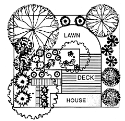This one-year course offers instruction in design and maintenance techniques for the landscaping and greenhouse professions. Students study the use, growth and proper care of plants, ground covers, trees and shrubs. An emphasis is placed on learning design techniques for landscaping and the drawing to scale of landscape plans. Students learn how to grow various herbaceous, ornamental and woody plants used in the industry. Students also study the use, growth, and proper care of plants, ground covers, trees and shrubs for landscaping, as well as turf management. Proper use of landscape tools and equipment is included. Students will gain additional employment skills by having the opportunity to participate in local internships.
Virginia Beach City Public Schools ensures equal access to all CTE courses. Accessibility accommodations will be provided as needed.
|
Landscaping |
|||||
|
Unit |
The Nature of Technology  |
Landscaping Technology and Society  |
Design and Engineering in Landscaping Technology  |
Applying Design Processes in Landscaping Technology  |
Select and Apply Technology in Landscaping Technology |
|
Focus |
Technology is a varied field of study. Students will examine the definition and applications of landscaping. |
Technology is strong influence on society. Students will understand and describe the impact of landscaping. |
Resources are the raw materials of a technological system. Selecting and applying them toward a landscaping solution is essential. |
Technology is a tool to assist in solving complex landscaping problems. A systems approach is a framework to design solutions. |
The role of technology is diverse. Identifying the role of technology in landscaping is essential to an improved understanding. |
|
Transfer Goals |
|
|
|
|
|
|
Unit Learning Targets |
|
|
|
|
|

